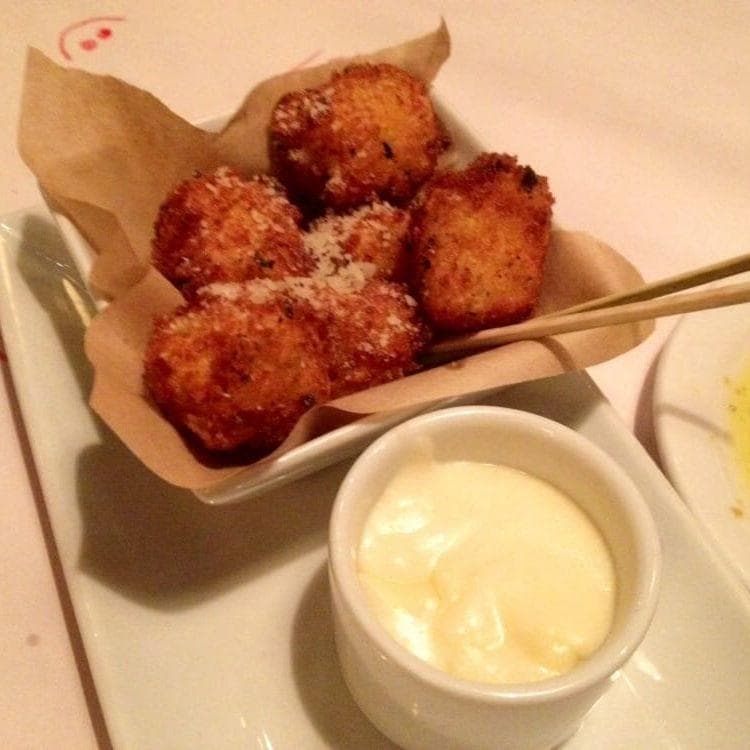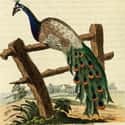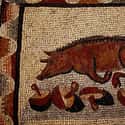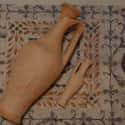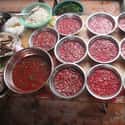-
(#1) Peacock
Meat was a delicacy for people of the ancient Roman world, and oftentimes it was almost exclusively consumed by the rich. Even so, exotic meats like peacock were even more of a rarity. Peacock was mostly served as cooks tried to impress guests of the rich, and while not common, it ended up on the table enough in all forms - including peacock tongue.
According to Apicius, a collection of recipes and food facts dating back to the first century AD, peacock was among "first rank" dishes, outranking rabbit, lobster, chicken, and pork in luxury. Alongside the flesh and tongues of peacocks - parts of the animal that had to be tenderized properly - Roman elites also ate peacock eggs, again considered the top among their counterparts.
-
(#2) Sow's Womb
The ancient Romans really loved sterile sow's womb. Romans spayed their pigs before slaughtering them (or didn't let them have piglets), ideally keeping the womb pristine in both texture and taste. The most famous cookbook from antiquity, Apicius, detailed numerous recipes featuring this delicacy, often accompanied by udders and belly flesh.
One way to prepare a sow's womb was by cooking it in "pepper, celery seed, dry mint, laser root [similar to fennel], honey, vinegar and broth." Romans also grilled sow's womb, coating it in "bran, afterwards put in brine" and cooked.
-
(#3) Parrot
One of ancient Rome's most famous gourmands was the third-century emperor Elagabalus (r. 218-222 AD), who loved hosting extravagant parties more than pretty much anything else. Ancient gossip in the Historia Augusta reports that he was a true glutton who enjoyed serving even his attendants the greatest delicacies. The text reports, "He served to the palace-attendants, moreover, huge platters heaped up with... heads of parrots, pheasants, and peacocks."
The Roman affinity for exotic birds similarly extended to flamingo. Both parrot and flamingo were cooked by boiling the meat in salt, dill, and vinegar, later adding leeks and coriander. Apicius reports the birds were then infused with pepper, cumin, and other herbs, sweetened with dates, and braised. Some recipes included additional flavors like celery seed, mint, and shallots.
Romans were also interested in parrots as conversationalists. According to Pliny the Elder (d. 79 AD), the parrot was interesting due to its ability to "imitate the human voice... [and] converse." He noted, parrots "will duly salute an emperor, and pronounce the words it has heard spoken; it is rendered especially frolicsome under the influence of wine."
-
(#4) Giraffe And Camel
While digging in Pompeii, archaeologists discovered the remains of a giraffe bone in the drain system of an ancient restaurant. Butchering marks were found on the leg joint, indicating that the animal was eaten; how it got there from the arena remains a bit of a mystery, especially since it's apparently the only giraffe bone ever recovered from an Italian excavation.
Camels were another occasional delicacy that Romans enjoyed. An excavation of a midden (an ancient dump) from Rome yielded camel bones, indicative of Elagabalus's (r. 218-222 AD) predilection for eating the animals' heels. According to Elagabalus's biography, the emperor, "In imitation of Apicius... frequently ate camels-heels and also cocks-combs taken from the living birds, and the tongues of peacocks and nightingales, because he was told that one who ate them was immune from the plague."
Writing in the fifth century AD, Roman physician Caelius Aurelianus criticizes the use of "camel's brain" as a remedy for epilepsy by his predecessors, attesting to beliefs surrounding the medicinal properties of camels.
-
(#5) Weasel
Weasels weren't regularly served up at Roman feasts, but they were sure handy if someone was suffering from epilepsy. Pliny the Elder wrote, as a treatment for epilepsy, "The brains of a weasel are also considered very good, dried and taken in drink; the liver, too, of that animal, or the testes, uterus, or paunch, dried and taken with coriander, in manner already mentioned."
Also, weasel flesh, when combined with salt, supposedly helped heal people stung by snakes.
Just as he did with respect to camel brains, Caelius Aurelianus, writing in the fifth century AD, challenged the idea that weasel was a curative for epilepsy.
-
(#6) Lamb brain
Brains are a common food mentioned in Apicius, with those of young cows and sheep featured throughout the cookbook. One of the recipes includes such bizarre ingredients as lamb brains, eggs, pepper, and rose petals. Brains were used to stuff sausages or other meat dishes, essentially featured as stuffing.
Apicius's recipe for Apician jelly incorporates either the sweetbreads of lamb or calf with a host of ingredients including raisins, honey, mint, nuts, and cheese. Once the concoction was prepared, it was covered and buried in the snow or chilled in some other fashion until firm.
-
(#7) Garum
Instead of ketchup, the ancient Romans used another tasty condiment: garum.
Sold in large and small quantities alike, garum (also called liquamen) was “prepared from the intestines of fish and various parts which would otherwise be thrown away, macerated in salt; so that it is, in fact, the result of their putrefaction.” Garum was often mixed with honey, vinegar, or other additives and even came in kosher varieties.
According to first-century naturalist Pliny the Elder, garum could be expensive. He described how "a garum of mackerel from the fisheries of Carthage is the most highly prized... hardly any other liquid commands such prices, apart from perfume." Because it could be cost-prohibitive, lower-class Romans often opted to replace garum with allec. Originally made from anchovies, allec was essentially the remnants of a good garum or was made out of smaller, cheaper fish.
-
(#8) Dolphin, Jellyfish, And Sea Urchin
The Romans loved seafood, even dining on dolphin on occasion. Although not actually a fish, dolphin was a potential candidate for salt fish balls in wine sauce. The recipe called for a mixture of sea creature flesh with spices like mint, parsley, and pepper. After all of the ingredients were blended and formed into balls, they were poached in "wine, broth, and oil."
Dolphin was an excessive culinary treat prohibited by sumptuary legislation. Wealthy Romans like Rutilius Rufus found ways around these laws, however, buying "his fish from fishermen who used to be his slaves... including delicacies like dolphin and swordfish."
Much like dolphin, jellyfish wasn't the most common item on a Roman menu. When it did appear, however, jellyfish was part of a salad.
Slightly more present in Roman cuisine was sea urchin. During the same Pompeii excavation in which scientists uncovered a giraffe bone, they also found the remains of a sea urchin. Apicius advocated using sea urchins on top of a mega-casserole that featured everything from brains to cheese, or on their own. Sea urchins were boiled or eaten raw, stuffed with egg and honey, or simply sprinkled with salt and pepper.
-
(#9) Dormice
Household mice in Rome were kept at bay by weasels rather than cats. Dormice, however, were much larger than traditional mice and were incorporated into culinary practice. For a time, there were laws prohibiting the consumption of dormice, but Romans continued to hunt the creatures.
In order to bring dormice to the dinner table more efficiently, Romans began raising them. Romans hand-raised dormice to fatten them up, keeping them in jars stuffed with acorns, beechnuts, or chestnuts. Once the mice got chubby, Apicius recommended butchering them and stuffing them with "pork and small pieces of dormouse meat trimmings, all pounded with pepper, nuts, laser, broth."
First-century Roman satirist Petronius describes another way to prepare dormice in his Satyricon, noting they were "rolled in honey and poppy-seed, and supported on little bridges soldered to the plate."
-
(#10) Blood Pudding
Blood pudding was an easy dish to cook and ingredients for the dish were readily available. Sacrificed animals and those slain in arenas were repositories of blood, featured in affordable foods like blood sausage and pudding. Blood sausage and pudding could be sold at the market, although the vendors who sold them fell fairly low on the social ladder.
Apicius suggests mixing blood with egg yolks, spices, and nuts, then putting the sauce into an intestine and cooking that mixture to perfection. In contrast to black sausages associated with the British, Roman recipes used onion to absorb the liquid instead of oats or some other grain.
Interestingly, one reported method of detecting Christians in ancient Rome was to offer them a blood sausage, which they were forbidden to consume. Tertullian (d. 220 AD) questioned what he saw as an ironic technique, putting forward to Christian persecutors, "What a strange thing is it, that you who are confident that the Christians are so religiously averse to the blood of beasts, should imagine them so sharp set upon the blood of men?"
-
(#11) Posca
While the rich drank wine and dined on delicacies, the poor had a much more pedestrian diet. Without access to the best vintages, many Romans opted for posca - water mixed with vinegar and some sort of seasoning. Posca could also include lemon juice and later came to incorporate eggs, other types of fruit juice, and some wine.
Posca was the drink of Roman soldiers because it energized and refreshed the consumer, disinfected non-potable water, and was easy to make. Members of the lower classes drank posca and, while statesman like Cato the Elder (d. 149 BC) enjoyed the drink, elites generally stuck to wine.
Less appealing than posca, however, was lora, a wine usually consumed by slaves. Lora was made by soaking seeds and other detritus from wine in vinegar to seep out any latent flavor.
-
(#12) Ostrich
Another animal imported from abroad, the ostrich was a recorded rarity on Roman tables. Roman physician and philosopher Galen (d. c. 216 AD) thought they were gross; he wrote that "their flesh is full of residue" and hard to cook. Ostrich eggs were, on the other hand, highly valued. They were praised for their size and flavor.
Apicius found some value in ostrich meat, however, offering recipes for boiled ostrich and ostrich stew. Emperor Elagabalus (d. 222 AD) loved the flightless birds. According to the Historia Augusta, "Sometimes at his banquets he served ostriches, saying that the Jews had been commanded to eat them." The latter claim about Jews eating ostriches wasn't true - there was a prohibition against eating them - making this perhaps a weird practical joke on Elagabalus's part.
On another occasion, Elagabalus "brought in the heads of six hundred ostriches in order that the brains might be eaten."
New Random Displays Display All By Ranking
About This Tool
With the continuous expansion, ancient Rome changed from a small city-state to a powerful Roman Empire. The territory of the ancient Roman Empire was very vast, with a rich variety of products and foods. The life of the Romans has undergone major changes, especially in terms of food, and the food of nobles and commoners was different. The ancient Roman nobles began to admire luxury and pleasure, which resulted in many strange foods and customs.
Are you interested in ancient Roman foods? There is never a shortage of different cuisines, the random tool focus on introducing 12 weird foods from ancient Roman, such as parrot, weasel, peacock, etc.
Our data comes from Ranker, If you want to participate in the ranking of items displayed on this page, please click here.








